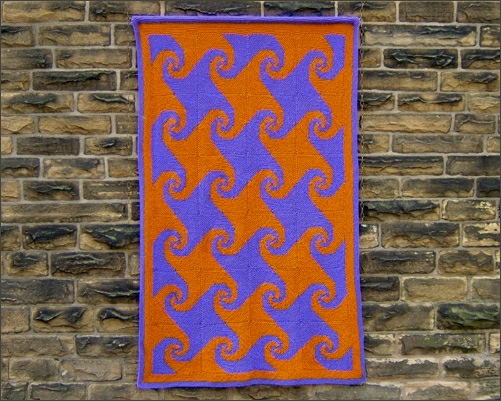




Over the years we had amassed many ideas that might be used some time in the future. This was one that sat around for a very long time. We had seen something similar to this on the cover of Mathematics Teaching (the journal of the Association of Teachers of Mathematics) and adapted it for our own purposes but could not find a way to make it within our rules. We could do everything except the points where the four spirals come together.
In 1996 I went to an American knitting convention where one of the workshop leaders was designer and teacher, Ginger Luters. She had made a jacket with a design closely related to this. Looking at her work, the final piece fell into the jigsaw and the rest was plain sailing.
Somewhere along the way, we had realised that the ‘square in a square in a square’ design, we were so fond of, had even more potential. By using the same two colours as before but positioning them differently, and using four tiny squares at the centre instead of one, we could create something that looked like a spiral made out of triangles. With a bit of research we found that this is called a Baravelle Spiral. One unit made like this looks good but when several are put together it turns into something that is far more than the sum of the parts.
This is another afghan which is seen in different ways by different people. Is it purple spirals on orange or orange spirals on purple? Two colours of equal intensity will always fight with each other for attention. Everyone sees one first but then most see the other, closely followed by the two jumping backwards and forwards to gain precedence.
We have another cushion version of this and From Square to Eternity, which are not pictured here. They are in two shades of grey and we found that many children could ‘understand’ them more easily when we asked them to shade the appropriate triangles to make the two different designs. Some children (and adults) find it very difficult to separate shape and colour. This is why our earlier books contained no colour. When we were wanting people to concentrate on shapes we found that colours were a very confusing distraction.
